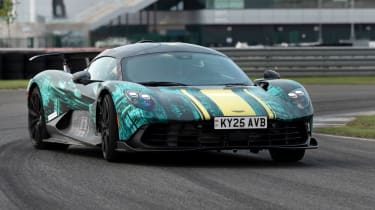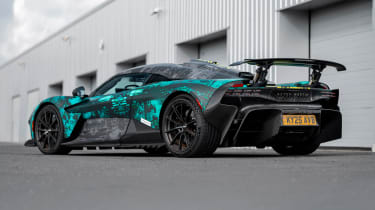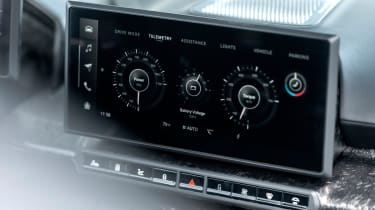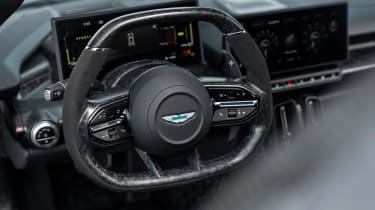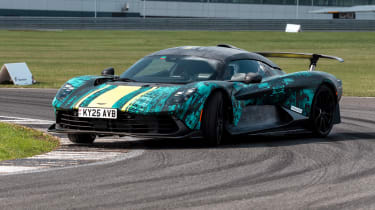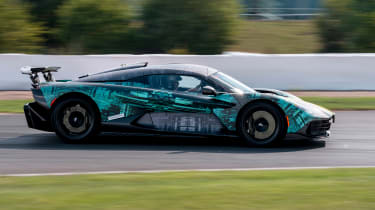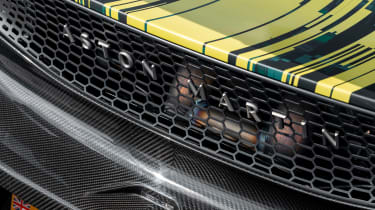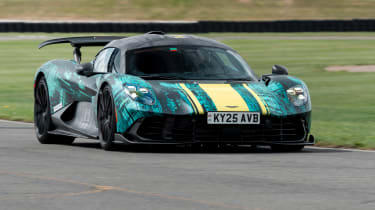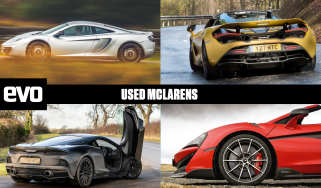Aston Martin Valhalla prototype 2025 review – Fernando Alonso's 1064bhp company hypercar on the limit
After years of development, we get behind the wheel of Aston Martin’s plug-in-hybrid mid-engined hypercar on track in prototype form
This is our first opportunity to drive the Aston Martin Valhalla, in pre-production prototype form. This is not Aston Martin’s first mid-engined car – there’s been the Valkyrie and the (one-off) Bulldog. Nor is it its first car with a carbonfibre chassis – there’s been the One-77, Vulcan and aforementioned Valkyrie. But it will be Aston’s first series-production mid-engined car, its first plug-in hybrid, its first with an electrified front axle, its first to enter a whole new market segment for the brand.
So it’s difficult to know exactly what to expect when we arrive at Stowe, the small infield circuit within Silverstone where Aston Martin has a permanent research and development base. The Valhalla we’re driving here is an ‘off-tool’ prototype (hence its graphical camouflage), physically and dynamically representative of customer-spec cars. Software is yet to be finalised, and Aston Martin says this car’s interior is not entirely representative of final production spec, though it’s very close. More on the Valhalla from inside its cockpit shortly, but first, a recap of its basics.
> Ferrari SF90 XX Stradale review – flat-out in the 1016bhp road-legal XX
Aston Martin Valhalla: in-depth
Since Valhalla was first shown in public as the AM‑RB 003 concept car all the way back at the 2019 Geneva motor show, it’s undergone an on-again-off-again development phase, extensive re-engineering, a switch from an in-house V6 to an AMG-sourced V8, and seen four different CEOs in the Aston Martin boardroom. Production will be limited to 999 cars and is already underway. The ‘basic’ price starts at £850,000, with many customers expected to spec bespoke ‘Q’ personalisation options. First deliveries are scheduled to take place this autumn.
More reviews
Although the Valhalla has previously been described as the ‘son of Valkyrie’, there are few genetic links between the two cars. The £2.5m, actively suspended, V12 Valkyrie was a specialised moonshot of a machine, but knowledge from the project has informed the Valhalla’s active aero, composite construction and F1-influenced ethos.
The Valhalla we’re driving here is an ‘off-tool’ prototype (hence its matt-black finish and graphical camouflage), physically and dynamically representative of customer-spec cars. Software is yet to be finalised, but nonetheless this machine is very close to the final product.
We meet the car for the first time in the pitlane, laptop-clutching engineers conducting final checks. Even with the camouflage to deliberately disrupt the predominantly carbonfibre body’s lines, I think the Valhalla looks fantastic. Behind the traditional Aston Martin grille integrated into the low-lying nose is an active single-piece front wing. Two diffusers ahead of the front wheels also play a part in the effect of the underfloor aero surfaces. Airflow from the wheelarches is even directed through the doors’ inner surfaces, and out into ducts for the engine and oil coolers.
The rear wing is motorised too, lying flush with the body in the Valhalla’s typical driving modes. In Race mode, it’s raised by 255mm on hydraulic struts, and rearwards slightly too, for optimum airflow. Under braking, it can stand upright as an air brake. At other times it’s adjusted actively for a stable aero balance, working in conjunction with the front wing. From 149mph, the Valhalla is generating more than 600kg of downforce. It actively bleeds the aero surfaces from that point all the way up to its electronically limited 217mph maximum, to maintain the same level of downforce for consistent handling at higher speeds.
The Valhalla adopts passive suspension (albeit with adaptive dampers) rather than an active system as per the Valkyrie. The front springs and dampers are mounted inboard (partly to get the scuttle nice and low for forward visibility) and exposed to be visible from the outside as a neat design detail. Rear suspension is a five-link layout. Unlike in the Valkyrie, the engine is not a stressed member of the chassis, cradled instead in an aluminium subframe. As a result, sound and vibration are not overwhelming.
In fact, the engine mounts were revised during development to deliberately let a little more vibration and sensation through to the driving seat. The 4-litre twin-turbo V8 is closely related to that of the AMG GT Black Series but with many differences: altered internals, manifolds, new turbos and more besides. It has a flat-plane crank as opposed to the cross-plane layout of the V8s found in other Aston Martin models.
The engine develops 817bhp on its own and is supplemented by three electric motors: two at the front, and one at the rear, incorporated into the transmission. There is no physical link between the front and rear axles, and the gearbox is the first dual-clutch unit to be fitted to an Aston Martin. It has eight speeds and no reverse; that’s taken care of by the front motors, which also enable torque vectoring to aid lateral agility and traction. Meanwhile the rear motor also assists the engine with torque-fill.
Inside the Aston Martin Valhalla
The cockpit has a stripped-back, race-car-ish atmosphere; a sort of deluxe Le Mans car vibe. It’s less plush than I’d expected. Slim composite surfaces, minimal trim. This particular car is full of forged carbonfibre: on the doors, steering wheel, dash, slim centre console and beyond. Customers will choose from an array of finishes and colours. As with most modern cars, two tablet-like digital screens sit on the dash, one in the centre, one behind the wheel. It would be nice to have some slightly more bespoke instruments for your £850k, but the displays are neat, crisp and clear.
There’s an excellent view over the low nose through the bowl-like windscreen. You’re very much installed within the carbon tub, created in collaboration with Aston Martin Performance Technologies (AMPT), the consulting arm of Aston’s F1 team. There are physical door mirrors but the main interior mirror displays a camera view, since there’s a solid bulkhead and no rear window. That makes space for distinctive twin upswept exhausts and a low-lying roof scoop, feeding charge-air coolers, turbo intakes and passive cooling for the ‘hot-vee’ engine. There are two further exhausts in the rear diffuser channels – the latter not as extreme as the Valkyrie’s, but still pretty cavernous Spartan though the interior may be, it is spacious. Handy, since there’s no boot: luggage space is limited to the passenger seat and footwell, plus lidded door bins, which will limit the Valhalla’s road trip potential. A shame.
Some of the switchgear is shared with other Aston models, in particular the selector and switches for the transmission and the tactile collar-like twist control for the driving modes, of which there are four: Pure EV, Sport, Sport+ and Race. In pure electric mode, the Valhalla is front-wheel drive and can travel at motorway speeds – up to 80mph or so – powered by the e-axle alone. Electric range is yet to be officially confirmed pending homologation, but expect it to be a low figure, potentially around the nine-mile mark; this is a car about performance rather than extended zero-emissions driving.
Each mode alters the settings and calibration for the torque vectoring, the hybrid system integration, damper stiffness and active aero. Sport, which utilises the whole hybrid powertrain, is the default mode on start-up. Given that our time with the car is limited, we prioritise Sport+, which enables the full 1064bhp, and Race, which unlocks the aero surfaces’ full potential.
Driving the Aston Martin Valhalla
Stowe is a little too slow and twisty to feel the aero’s full effect, but its tight corners and short straights will give us a flavour of the Valhalla’s low-to-mid speed agility, and its acceleration. The dihedral-hinged doors open wide and take a large section of roof with them, leaving a sort of T-bar strip when they’re both open. You step in, then lower yourself into the seat, rather than the duck-and-twist move common to most butterfly-doored supercars. The one-piece carbon seats are canted back in a reclined position; not quite as extreme as in the Valkyrie (and with a regular over-the-shoulder seatbelt rather than a multi-point harness) but a similar lay-down driving position.
Despite the enormous power output, the Valhalla is a confidence-inspiring car, and one that you can rapidly adapt to. It pulls away as smoothly as you’d expect of a hybrid and gearchanges are mostly silky from the dual-clutch transmission, albeit with a couple of abrupt and hesitant moments during the test; a characteristic of the not-yet-final software, Aston Martin says, and a quirk that won’t be present on customer cars.
Power delivery is remarkably linear. The Valhalla has bigger turbos than the Black Series, which would ordinarily mean more lag, but with the e-motor torque-fill assistance, that’s not an issue. Acceleration is a smooth, sustained shove, rather than a dramatic sledgehammer wallop. As a result, there’s a little less shock and awe than I’d expected. Not least because there’s not much in the way of engine sound. It’s difficult to gauge the Valhalla’s real volume since I’m wearing a tight-fitting crash helmet with in-built radio cans, which mutes things considerably. But I was expecting a little more V8 rasp and rumble; perhaps unrealistically, given the turbocharged powertrain, electric assistance and stringent modern noise regs.
Naturally it’s tricky to draw conclusions on ride quality on a smooth-surfaced test track, but the Valhalla’s suspension rides the kerbs very smoothly, at low and high speeds. Remarkably so, in fact.
What about the electrified front axle? This is the first all-wheel-drive Aston since the DBX – albeit a very different kind of AWD. You can feel the front e-axle engage on the exit of slow corners, subtly stiffening the steering a little like a mechanical diff in a front-wheel-drive hot hatch, but it doesn’t dominate proceedings. The Valhalla still feels very much a rear-wheel-drive car in nature. In fact, in the rate of its steering response and feedback through its touchpoints, it really does remind you of other Astons in the company’s range. You could climb from a Vantage into a Valhalla and feel threads from the same dynamic cloth, despite them being totally different vehicles.
Feedback through the brake pedal is excellent, despite juggling the demands of regenerative braking. It’s a brake-by-wire system, and when you hit the brakes it divides deceleration actively between the front electric motors and the carbon-ceramic brake discs. The front motors can be employed even during full ABS braking, and braking force can be distributed unequally across the front axle if required via the torque vectoring system. There is a second element of regeneration from the rear e-motor when the driver lifts off the throttle. Hitting the brakes with intent in Race mode, you can see the rear wing stand upright in the rear-view camera.
Despite the reclined driving position, I find myself craving a bit more support for my upper body from the carbon-shell bucket seat and slide it a touch closer to the wheel – which itself is an unusual rectangular shape. During normal lapping there’s no need to move your hands from a quarter-to-three position. While using a lot of lock manoeuvring at parking speeds, however, or experimenting with sliding the car, I find myself grabbing fresh air and craving a conventional round wheel. A couple of times I accidentally catch buttons on the wheel’s spokes and inadvertently change the layout on the digital instrument panel.
I’d expected 1064bhp to make Stowe feel like a kart circuit but there is the space to stretch the Valhalla a little; the straights are long enough to get into fifth gear, which is Jolly Quick. It’s a precise, linear car in every respect. Undramatic, even. That’s a compliment rather than a criticism, but I do wonder if some might crave a little more theatre and intensity.
That said, one of the biggest surprises of the day is just how approachable the Valhalla is for such a powerful car. There are multiple stages for traction and stability control, as per other Astons such as the Vantage, and I’m encouraged to switch all of the systems off, to feel how approachable the Valhalla can be even without electronic assistance. I’m initially apprehensive to do so given the 1000bhp-plus output, but it turns out this really is a car you can grab by the scruff of the neck and sling around. It’s not snappy; it’s progressive, with a feel unlike many other cars I’ve driven. Exiting corners with some power oversteer, there’s the unusual feeling of the Valhalla sliding at the rear but still being driven forward by both axles as the front motors engage. You can carry an immense amount of momentum.
While customers can choose magnesium wheels and track-focused Michelin Cup 2 tyres with a special AML construction specifically for the Valhalla, this car is on the second, more road-friendly choice, Pilot Sport S 5s – again, to a bespoke spec – on forged alloy rims. They lend it a friendlier, more accessible balance at the limit while still generating impressive lateral grip and traction.
More than most cars, it will be intriguing to see how Aston Martin’s first series-production mid-engined model feels on the road. Despite its track look and leanings, to me it feels as if it could be a very capable and well-resolved car on road (lack of luggage space notwithstanding).
Price and rivals
Obvious rivals are difficult to pin down. The Valhalla sits in curious clear air between supercar and hypercar. It’s considerably less money than the £3.6m Ferrari F80 and upcoming £2m McLaren W1 but nearly double the price of the Lamborghini Revuelto, for example, which has a similar three-motor hybrid powertrain make-up, albeit with a naturally aspirated 6.5-litre V12.
The Lamborghini has a similar power output and top speed but a less downforce-led design, less exclusivity as a car for continuous production rather than a limited edition, and a more road-biased focus – though we’ve discovered in testing that it’s also hugely fun, challenging and rewarding on a circuit, too. Ferrari’s now out-of-production SF90 was priced at around £390,000 and likewise featured a twin-turbo 4-litre V8 and three electric motors, with limited luggage space. Its rumoured replacement will surely top £500k.
The SF90 was a car that polarised opinion and the Valhalla may do likewise – it will be intriguing to experience it in finalised form, and against the SF90’s replacement. In the meantime, its precision, linearity and the accessible nature of its performance make a strong impression here at Stowe. The non-hybrid, £1.2m Praga Bohema also offers a carbon structure, serious downforce and a reclined driving position but it’s a more extreme, more track-focused and road-compromised experience.
What does a mid-engined hyper-hybrid Aston Martin feel like? On the basis of this brief first encounter, like nothing else. The Valhalla has a character all of its own, and a compelling one at that. The key question is how it will feel on a larger circuit with space to bring its downforce to life – and, most importantly, out on the road. We’ll know the answer to both those questions in the coming months.
Aston Martin Valhalla specs
| Engine | V8, 3982cc, twin-turbo plus three motors |
| Power | 1064bhp |
| Torque | 811lb ft |
| Weight | 1655kg (dry) |
| Power-to-weight | 653bhp/ton (dry) |
| 0-62mph | 2.5sec |
| Top speed | 217mph (limited) |
| Basic price | c£850,000 |
